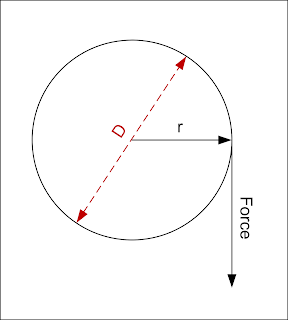031 :: lets look at some forces
In our case, stepper with pulleys transfering force thru the belts.
I have in my arsenal, MXL, HTD3 and XL pulleys of various sizes. lets have a look at what kind of real forces we can get in theory (and possibly practically)
Diameters measured around the teeth area:
MXL 21 teeth = 13mm
HTD3 18 teeth = 16.5mm
XL 13 teeth = 21mm
Most modern stepsticks like A4988/A4983 can churn out 1/16 microsteps, a 200step/rev stepper will need (200x16) steps to achieve 1 full 360degree rotation. Each step = (360/3200) = 0.1125 degrees, and a total of 3200 steps is required.
if we factor in the thickness of the belt into calculating for the actual radius and assume it simply to be half of the total thickness, we can then calculate that each microstep that the stepper makes will result in the following actuated movement in the belt :
MXL belt overall thickness = 1.14mm thick
HTD3 belt overall thickness = 2.4mm thick
XL belt overall thickness = 2.2mm thick
Distance moved = pi*(D+ (beltthickness/2) ) * (0.1125/360)
HTD3 = 0.01738mm
XL = 0.02170mm
if we were to double up the belt around an idler (like a rope block on ropes). You will now require the pulley to turn twice as much to move the target the same distance, this effectively doubles the precision. So now with this setup, the MXL can grab a precision of 0.0067mm or 6.7um (yep micro-meters!).
Just for the fun of it, to achieve exactly 10um of movement, you should try to look for something with a radius of 0.01 = pi*D*(0.1125/360) = 10.19mm (raduis 5mm++). Which is really small, so doubling it up will do nicely (5um precision!). in EAGLE cadsoft or KiCad, we always refer to PCB routing in mills (1/1000th of an inch). 1 mil = 0.0254mm, which is 25.4um. If there is a way to empower the machine to consistently achieve accuracies of 5um, it might just be possible to do jobs of 1mil.
if we were to double up the belt around an idler (like a rope block on ropes). You will now require the pulley to turn twice as much to move the target the same distance, this effectively doubles the precision. So now with this setup, the MXL can grab a precision of 0.0067mm or 6.7um (yep micro-meters!).
Just for the fun of it, to achieve exactly 10um of movement, you should try to look for something with a radius of 0.01 = pi*D*(0.1125/360) = 10.19mm (raduis 5mm++). Which is really small, so doubling it up will do nicely (5um precision!). in EAGLE cadsoft or KiCad, we always refer to PCB routing in mills (1/1000th of an inch). 1 mil = 0.0254mm, which is 25.4um. If there is a way to empower the machine to consistently achieve accuracies of 5um, it might just be possible to do jobs of 1mil.
Lets now see what kind of force is exerted on the belt : T = r x F
 Assuming that we are able to achieve 100% of the stepper torque output exactly, we can try to simulate thru maths for a sanyo denki @ 42N.cm :
Assuming that we are able to achieve 100% of the stepper torque output exactly, we can try to simulate thru maths for a sanyo denki @ 42N.cm :
F = Torque / (r + belt thickness)
1kgf = 9.807N
plugging in the radii we have ...
T(MXL) = 42 / (1.3cm + 0.057) = 30.95N (3.16kgf)
T(HTD3) = 42 / (1.65 + 0.12) = 23.73N (2.42kgf)
T(XL) = 42 / (2.1 +0.11) = 19.00N (1.94kgf)
As we can see, the MXL combination packs quite a punch. For this reason, we also look at a few websites which reccomends that with our MXL belt/pulley combination, we should not exceed 16-20N.cm loading. So if we are really fully loading this stepper with 42N.cm output, we will be overloading it by about 100%. (breaking strength about 72N per mm, which works out to about 450N). Looking at the breaking limit, a 30N load may not be so bad, it might elongate the belt prematurely (by most datasheet standards, this is about an extension of 3-5%).
HTD belts by comparison, has 3.5 times the capacity of MXL generally, XL belts although the largest of the 3 here, is only 1.5 times and GT2 belts are nearly 1.4 times (just having this model here for comparison). it is really interesting to note that XL belts have such a low loading factor for its size.
http://files.catalogds.com/domains/bbman/trumotionsyncdata_final_3-8-07.pdf
http://www.sdp-si.com/D155/PDF/D155_3.pdf
HTD belts by comparison, has 3.5 times the capacity of MXL generally, XL belts although the largest of the 3 here, is only 1.5 times and GT2 belts are nearly 1.4 times (just having this model here for comparison). it is really interesting to note that XL belts have such a low loading factor for its size.
http://files.catalogds.com/domains/bbman/trumotionsyncdata_final_3-8-07.pdf
http://www.sdp-si.com/D155/PDF/D155_3.pdf
So in conclusion, these being manufacturers recommendations for safe working limit or extended lifespan, I should be getting some CHINA made MXLs to try and we shall know how well it handles the 3kgf. But different manufacturers do have very different load specifications.
... to be coninued





Comments
Post a Comment
feel free to ask me anything